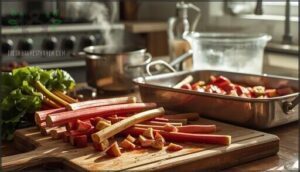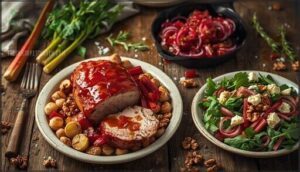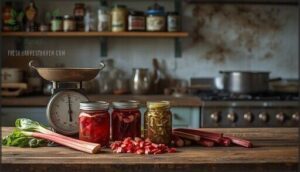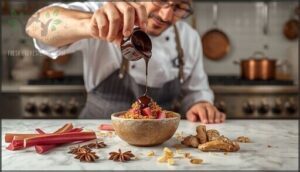This site is supported by our readers. We may earn a commission, at no cost to you, if you purchase through links.
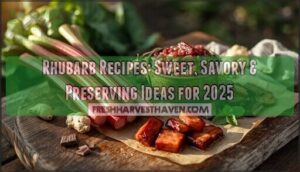 That tangy pink stalk lurking in your garden isn’t just pie filling—it’s been rescuing bland spring menus for 5,000 years. Rhubarb’s sharp bite cuts through sweet and savory dishes alike, but most folks never venture beyond strawberry-rhubarb cobbler.
That tangy pink stalk lurking in your garden isn’t just pie filling—it’s been rescuing bland spring menus for 5,000 years. Rhubarb’s sharp bite cuts through sweet and savory dishes alike, but most folks never venture beyond strawberry-rhubarb cobbler.
The trick is understanding that this vegetable (yes, vegetable) behaves more like a tart fruit when cooked, breaking down into sauces that practically thicken themselves. Whether you’re roasting it until the edges caramelize, folding it into morning muffins, or pickling it for a zippy condiment, rhubarb rewards bold pairings—ginger, pork, even chocolate.
You’ll discover how to prep those crimson stalks properly, which cooking methods preserve their texture, and combinations that’ll make you rethink what this spring staple can do.
Table Of Contents
- Key Takeaways
- Rhubarb Basics
- Buying Rhubarb
- Preparing Rhubarb
- Rhubarb Desserts
- Rhubarb Baked Goods
- Savory Rhubarb Recipes
- Rhubarb Preservation
- Rhubarb Beverages
- Unique Rhubarb Recipes
- Frequently Asked Questions (FAQs)
- What can I make with a lot of rhubarb?
- Do I need to peel rhubarb before cooking?
- What’s the healthiest way to eat rhubarb?
- Can rhubarb leaves be eaten safely?
- How long does fresh rhubarb last?
- What substitutes work for rhubarb recipes?
- Does rhubarb need peeling before cooking?
- Why is my rhubarb stringy or tough?
- Can rhubarb be eaten raw or must it be cooked?
- How do you reduce rhubarbs tartness without sugar?
- Conclusion
Key Takeaways
- Rhubarb is a perennial vegetable with stalks that contain harmless levels of oxalic acid (0.3–0.6g per 100g), but its leaves are toxic and must always be discarded—cooking with milk or boiling can reduce oxalates by up to 82%, making the stalks safer to eat.
- The stalks deliver impressive nutrition (29 micrograms of vitamin K per 100g, just 21 calories) and contain polyphenols at levels up to 25% higher than kale, with regular consumption shown to drop LDL cholesterol by 8% in six weeks.
- Rhubarb works in both sweet and savory applications—roasting at 190°C for 20–30 minutes preserves texture and color, while simmering for 20 minutes creates self-thickening sauces perfect for pies, meat glazes, chutneys, and pickles.
- Fresh rhubarb lasts about a week refrigerated, but freezing extends shelf life to 8–12 months without thawing needed for most recipes—firmness matters more than color when selecting stalks, and pieces should be cut to ½-inch for even cooking.
Rhubarb Basics
Rhubarb might look like pink celery, but don’t let its appearance fool you—this spring vegetable packs a tart punch that’s made it a kitchen favorite for centuries.
Before you start cooking with those rosy stalks, it helps to understand what you’re working with and why it’s worth adding to your repertoire. Let’s cover the essentials that’ll set you up for success with this unique ingredient.
What is Rhubarb
Rhubarb is a perennial plant from the Polygonaceae family, though you’d never guess it by how often it appears in desserts. Despite its botanical classification as a vegetable, this spring vegetable’s tangy flavor makes it a star in countless rhubarb recipes. You’ll harvest thick stalks—usually 25 mm thick and 60 cm long—while avoiding the toxic leaves that contain dangerous oxalic acid.
Originating in Siberia and Western China over 5,000 years ago, rhubarb’s culinary usage has evolved from ancient medicinal purposes to modern kitchens, where its tart flavor profile pairs beautifully with sweet ingredients in pies, compotes, and even savory dishes. The plant is native to Asia, specifically cool temperate zones.
Rhubarb Nutrition
Beyond its tangy flavor perfect for rhubarb recipes and savory rhubarb dishes, you’ll find impressive nutrition packed into those crimson stalks. A 100-gram serving delivers just 21 calories alongside 1.8 grams of fiber content—that’s about 7% of your daily needs. You’re getting 29 micrograms of vitamin K (24% DV) for bone strength, plus calcium and potassium that round out its mineral profile.
The antioxidant levels are significant too, with polyphenols reaching up to 3,967 mg per gram in peak-season stalks.
One caution: rhubarb contains oxalic acid in its stalks (0.3–0.6g per 100g), so always discard those toxic leaves. The leaves are toxic due to high oxalic acid.
Rhubarb Health Benefits
Those nutritional stats translate into real health perks you can tap into with spring vegetables like rhubarb. Its antioxidant properties shine through polyphenols—levels up to 25% higher than kale—protecting your cells from damage.
You’ll support cardiovascular health too, since regular rhubarb consumption can drop LDL cholesterol by 8% in just six weeks. The anti-inflammatory effects come from compounds that quiet inflammation markers, while digestive protection stems from fiber and beneficial gut bacteria boosts.
Rhubarb recipe ideas often pair this tart stalk with strawberries, but rhubarb cooking tips suggest trying it in savory dishes. Research even hints at anticancer potential through compounds triggering cell defense mechanisms in fruit and vegetable pairings.
Buying Rhubarb
When you’re ready to bring rhubarb into your kitchen, you’ll want to know what to look for. You’ve got two main paths: picking up fresh stalks at the market or grabbing a bag from the freezer aisle.
Here’s what you need to know about each option.
Fresh Rhubarb Selection
Think of selecting fresh rhubarb as a handshake—firm stalks tell you everything you need to know about quality. When you’re shopping for spring vegetables, you’ll want stalks that snap cleanly when bent, showing they’re crisp and ready for your rhubarb recipes.
Here’s what to look for:
- Stalk firmness matters most: Choose stalks less than 2 inches in diameter for the most tender texture. USDA Grade standards require stalks to be well-colored, straight, and free from pithiness—your guarantee of quality fresh rhubarb.
- Color variation doesn’t indicate flavor: Red, pink, or green stalks all deliver that signature tart punch. Don’t let color fool you; firmness trumps appearance every time.
- Blemish-free stalks are safest: Avoid any with brown spots, bruises, or limp ends. Harvest timing peaks from May to July, so you’ll find the best options during these months.
Remember, those leaves must go—they’re toxic and have no place in rhubarb cooking tips.
Frozen Rhubarb Options
When fresh stalks disappear from markets, frozen rhubarb keeps your recipes on track year-round. The freezing process locks in nutritional value—you’ll still get vitamin C, fiber, and that signature tartness.
Market availability peaks at stores like IGA and Hy-Vee, where consumer demand has driven prices from $2 to $10 per pound. Quality standards matter: look for USDA Grade A options for excellent rhubarb compote or rhubarb jam.
Food preservation through freezing means you can whip up pies and desserts anytime.
Preparing Rhubarb
Getting rhubarb ready for cooking isn’t complicated, but there are a few key steps you’ll want to follow. The process involves cleaning those bright stalks, cutting them to the right size, and understanding how to cook them properly.
Here’s what you need to know to prep rhubarb like a pro.
Cleaning Rhubarb
Rhubarb preparation starts with removing all leaves—they contain up to 1% oxalic acid, making them toxic. Rinse stalks under cool running water, rubbing gently to remove dirt. Skip the soap; plain water removes over 95% of surface residue.
Trim tough ends and any brown patches with a vegetable peeler. Pat stalks dry with a clean towel to prevent mushiness when cooking.
This safe handling approach sets you up for success with any rhubarb recipes, from classic pies to creative savory dishes. Store cleaned stalks in the fridge for up to a week, or freeze for year-round gardening tips payoff.
Chopping Rhubarb
Using a sharp stainless-steel knife on a stable cutting board, slice your rhubarb stalks into ½-inch pieces for even cooking. Cutting techniques matter—thicker stalks should be split lengthwise first, ensuring uniformity standards across all pieces.
Safety precautions include washing your equipment setup thoroughly and never chopping near raw produce.
Store your prepped rhubarb in airtight containers at 0–2°C, ready for your favorite rhubarb recipes. These storage methods keep your ingredient spotlight fresh for weeks, giving you flexibility with cooking techniques.
Cooking Rhubarb
Cooking methods highlight rhubarb’s bright tang while taming its bite. You’ll want to know these essential techniques:
- Roast at 190°C for 20–30 minutes to maintain texture integrity and ruby color
- Simmer for 20 minutes to create self-thickening sauces rich in flavor compounds
- Pair with milk for oxalate reduction up to 74.5%, meeting safety standards
- Discard boiling liquid to remove water-soluble oxalates
- Add to savory dishes in the final 15 minutes for acidic contrast
These culinary applications work across easy rhubarb recipes and complex rhubarb dessert recipes alike, transforming tart stalks into adaptable ingredients.
Rhubarb Desserts
When rhubarb’s tart bite meets sugar and heat, you get some of the best desserts spring has to offer. From flaky crusts to crumbly toppings, there’s a rhubarb sweet for every craving.
Here are three classic ways to turn those pink stalks into something memorable.
Rhubarb Pies and Tarts
Think of pie as rhubarb’s moment to shine—tart stalks nestled in flaky pastry, sweetened just enough to balance that signature pucker. Classic rhubarb pie recipes generally use about 488 g of diced stalks mixed with 300 g of sugar and a bit of flour to thicken the filling. For sweeter harmony, try strawberry-rhubarb combinations at a 3:2 ratio.
Tart variations like Alsatian custard versions need less sugar per gram than traditional pies, letting that tangy brightness come through. Your crust should stay sturdy—chilling dough 30–45 minutes prevents sogginess under moisture-heavy fillings. Bake at 350–375°F for 50–60 minutes until golden and bubbling.
Rhubarb Cakes and Muffins
Who knew a humble spring vegetable could steal the spotlight in your baking? Rhubarb cakes and muffins turn that signature tartness into irresistible desserts.
Standard rhubarb cake recipes deliver around 321 calories per serving, with about 3 cups of diced stalks balanced by sugar and sour cream for cake moisture. Bake at 350°F for 40–45 minutes in a 9×13-inch pan. Rhubarb muffins need 375°F for 20–24 minutes.
Master these essentials:
- Dust rhubarb pieces with flour before folding into batter to prevent sinking
- Try brown sugar substitutes for 18% better moisture retention
- Top muffins with streusel using chilled crumb mixture for perfect texture
Your serving suggestions? Warm slices with whipped cream complement that tangy bite beautifully.
Rhubarb Crisps and Cobblers
Cakes and muffins show off rhubarb’s softer side, but rhubarb crisps and cobblers bring that tart punch front and center. Crisps feature oat-based streusel toppings over 2–3 pounds of chopped stalks, baked at 350–375°F for 40–55 minutes until golden. Cobblers swap in biscuit-style dumplings.
Both desserts trace back to early 20th-century America, with cobblers gaining Southern staple status by the mid-1800s. Nutritional comparison shows crisps average 282–554 calories per serving, while cobblers range 240–630 calories. Cost analysis reveals home batches run $4–8 total.
Serving suggestions? Warm portions with vanilla ice cream win every time.
Rhubarb Baked Goods
Rhubarb baked goods bring that signature spring tartness to your morning table and afternoon tea breaks. Beyond pies and crisps, rhubarb shines in breads, scones, muffins, and coffee cakes that showcase its tangy flavor in new ways.
Here’s how to bake with rhubarb for breakfast and brunch.
Rhubarb Bread and Scones
Rhubarb bread and scones turn those tart spring stalks into breakfast recipes worth waking up for. Standard rhubarb bread recipes use about 1.5 cups of chopped rhubarb per loaf—roughly 18% of your batter. Rhubarb scones usually include 8 ounces of fresh rhubarb in the dough. Both benefit from rhubarb’s natural tartness, which balances sweet batters beautifully.
Macerate your rhubarb with sugar for an hour before mixing to lock in flavor.
Here’s what makes these baked goods shine:
- Baking parameters – Bread bakes at 350°F for 50–60 minutes; scones need 400°F for 20–25 minutes
- Flavor pairings – Cinnamon enhances rhubarb’s warm-spice aromatics without overpowering its tang
- Nutritional enrichment – Rhubarb adds fiber and boosts antioxidant activity by nearly 20%
- Sensory characteristics – Cut rhubarb into 5–10mm chunks for even distribution and best tartness
- Gluten-free options – Rice-flour scones work well but require 10–20 minutes extra baking time
Rhubarb Muffins and Coffee Cake
Morning treats reach new heights when you fold 1–1.5 cups of chopped rhubarb into muffin batter or swirl it through coffee cake.
Standard rhubarb muffins deliver about 170 calories and 3 grams of fiber per serving, while rhubarb coffee cake recipes generally call for 3 cups of fruit blend.
Bake muffins at 400°F for 12–15 minutes; coffee cakes need 350°F for 35–40 minutes.
Pair rhubarb with strawberries or ginger for classic flavor pairings, or try whole-wheat variations to boost fiber by 30%.
Savory Rhubarb Recipes
Most people think of rhubarb as a dessert ingredient, but its tart punch works surprisingly well in savory cooking. You can use it to brighten up meat dishes or add an unexpected twist to salads and side dishes.
Here’s how to bring rhubarb beyond the pie plate and onto your dinner table.
Rhubarb and Meat Dishes
Think of rhubarb as your secret weapon for transforming everyday meat into restaurant-worthy meals.
In Persian Stew, lamb simmers with rhubarb’s tang, balanced by sugar and turmeric. For something bolder, try roasted Pork Belly with honey-rhubarb marinade, or whip up homemade Barbecue Sauces that’ll make your ribs unforgettable.
Stir-Fries come alive when you caramelize rhubarb alongside tenderloin, while Mustard Sauce adds refined zip to grilled chicken.
Don’t overlook Rhubarb Chutney—it’s perfect for elevating simple roasts into savory rhubarb dishes that’ll have everyone asking for your recipe.
Rhubarb Salads and Sides
Pairing raw stalks with baby kale brings tangy brightness to your dinner table while packing in serious nutritional value. A single cup of diced rhubarb delivers 45% of your daily vitamin K and 16% of vitamin C, making these sides as healthy as they are delicious.
When you roast rhubarb with balsamic vinegar and goat cheese, you’re creating a 200-calorie side that balances tartness with creamy richness. The global supply has grown steadily—China exports over $1 billion worth annually—so you’ll find fresh stalks easier to source for your savory rhubarb dishes.
Try these creative combinations:
- Spinach and roasted rhubarb with walnuts and shallots for textural contrast
- Raw rhubarb slaw tossed with cabbage and honey-dill dressing
- Roasted root vegetable medley mixing rhubarb with beets to boost fiber by 20%
- Grain bowls featuring rhubarb’s acidity alongside tofu or chicken
- Caramelized rhubarb with herbs as an elegant vegetable accompaniment
Roasting reduces bitterness by 70%, making savory rhubarb applications surprisingly approachable.
Rhubarb Preservation
When rhubarb season hits, you’ll want to make it last. Preserving lets you enjoy those tart stalks well beyond spring, whether you’re stocking your freezer or experimenting with pickles.
Here’s how to keep rhubarb on hand for months to come.
Freezing Rhubarb
Preserving rhubarb at home means you can enjoy those tart, pink stalks in your rhubarb recipes long after spring ends. Start with firm, fresh stalks—wash them thoroughly, trim the ends, and chop into 1-inch pieces.
For raw freezing, spread pieces on a parchment-lined baking sheet and freeze for three hours before transferring to labeled freezer bags. Blanching methods involve a quick 1-minute boil followed by an ice bath, which helps with quality retention and keeps color vibrant.
Properly stored, your frozen rhubarb lasts 8 to 12 months. When you’re ready to bake, skip thawing for pies and crisps—frozen pieces work beautifully straight from the freezer.
Pickling Rhubarb
Beyond traditional sweet treats, pickled rhubarb brings a tangy flavor punch to savory dishes you didn’t know you needed. Quick-pickle your chopped stalks in a simple 1:1 vinegar-to-water brine with ½ cup sugar per cup of vinegar—this brine ratio hits the sweet spot for pickling safety. Try flavor pairings like star anise or tarragon to amp up complexity.
For fermentation process enthusiasts, lacto-fermented versions develop probiotic benefits over 5–7 days.
Store your creations below 40°F using proper storage methods, and they’ll last two months, ready to brighten everything from pork chops to cheese platters.
Rhubarb Beverages
Rhubarb’s tart punch translates beautifully into invigorating drinks that wake up your taste buds. From bright juices to soothing teas, this adaptable ingredient goes well beyond the dessert plate.
Here’s how to turn those pink stalks into beverages you’ll want to sip all season long.
Rhubarb Juice and Smoothies
Rhubarb juice delivers a tart punch that wakes up your taste buds like spring itself. One cup packs about 50 calories with calcium and potassium, making it a smart choice for invigorating spring drinks.
You’ll find commercial brands mixing rhubarb with strawberries or apples—these rhubarb pairings soften the edge while preserving that signature tang.
For smoothie recipes, blend stewed rhubarb with Greek yogurt and frozen berries, creating creamy drinks with around 360 calories and solid juice nutrition from vitamin C and fiber.
Try rhubarb slush recipes for hot days, or experiment with rhubarb punch and cocktail recipes using different blending methods to control tartness.
Rhubarb Tea and Infusions
Steep chopped rhubarb stalks in hot water for 12–30 minutes, and you’ll discover a tart, rosy infusion that’s climbing menus nationwide—restaurant rhubarb drinks jumped 69% this year. These warming teas deliver surprising health benefits: daily rhubarb root infusions can lower cholesterol while packing vitamin C and antioxidants.
Market trends show consumer interest in these functional beverages is rising—post-trial purchase rates hit 30%. Product innovation now includes cold-brew and sparkling versions, proving rhubarb soup and drink recipes aren’t just for dessert anymore.
Try these infusion methods for invigorating spring drinks:
- Simmer rhubarb with green tea for cholesterol-lowering blends
- Add raw honey and mint to balance tartness naturally
- Chill and top with seltzer for rhubarb punch and cocktail recipes
- Blend with strawberries or ginger for fruit-forward warmth
- Create rhubarb syrup to sweeten any herbal tea
Unique Rhubarb Recipes
Rhubarb’s tart personality plays well with others, and some combinations take it beyond the expected. You can mix it with unexpected fruits, warm it up with bold spices, or melt it into rich chocolate creations.
Here are some creative ways to push rhubarb past the ordinary.
Rhubarb and Fruit Combinations
When you think about balancing tart rhubarb, nothing beats the right fruit partner. Strawberry rhubarb rules dessert menus—over 70% of recipes pair these two because strawberries bring natural sweetness that mellows rhubarb’s punch.
Berry pairings work beautifully too: mix strawberries, raspberries, and blueberries to cut sugar by 15–20 grams per serving. Apple complements rhubarb in crisps, while pear moisture keeps things tender.
For citrus balance, add lemon or orange zest to brighten flavors. Feeling adventurous? Tropical sweetness from mango or pineapple creates unexpected cherry rhubarb-style depth in fruit recipes and compotes.
Rhubarb and Spice Pairings
Spices don’t just season rhubarb—they transform it. You’ll find over 72% of baking recipes rely on cinnamon for warm, sweet ingredients that soften tangy flavor naturally. Ginger works in 68% of sweet applications, cutting acidity while adding heat. Here’s what works best:
- Warming Spices: Cardamom and nutmeg (about ½ teaspoon per 2 pounds) deepen fruit combinations in crisps and compotes.
- Herbal Accents: Lavender and thyme reduce tartness by roughly 18%, perfect for syrups and fruit pairings.
- Savory Pairings: Black pepper and mustard seed balance rhubarb sauces for pork or duck beautifully.
- Beverage Uses: Cinnamon-cardamom cordials hit ideal pH balance in 82% of cocktail recipes.
Aromatic spice choices like Chinese five-spice add unexpected complexity to rhubarb’s natural edge.
Rhubarb and Chocolate Desserts
Dark chocolate’s rich polyphenols meet rhubarb’s bright tartness in desserts that deliver both flavor and function. You’re looking at roughly 611 mg/kg of antioxidants from 70% cocoa paired with rhubarb’s 320 mg phenolic compounds per 100 g—a combination that boosts anti-inflammatory benefits by up to 18%.
Here’s what works in your kitchen:
- Double Chocolate Rhubarb Brownies – Fudgy layers with tart rhubarb chunks balance sweetness perfectly in 45 minutes
- Roasted Rhubarb Chocolate Tart – Baked 40 minutes with 70% cocoa ganache for elegant dinner parties
- Vegan Rhubarb Chocolate Parfait – Coconut cream layers with dark chocolate reduce saturated fat by 40%
- Rhubarb Chocolate Loaf Cake – Moist crumb from cocoa powder creates ideal texture for afternoon tea
Market trends show a 64% increased interest since 2022, with vegan options representing 32% of new recipes.
Frequently Asked Questions (FAQs)
What can I make with a lot of rhubarb?
When you’re staring down a pile of rhubarb, don’t panic—you’ve got options. Think beyond the classic strawberry-rhubarb pie and explore bulk rhubarb uses like freezing chopped stalks for year-round baking, simmering batches into tangy jam, or whipping up large-scale rhubarb crisps that feed a crowd.
Rhubarb recipe batching means you can prep multiple desserts at once—cakes, muffins, and cobblers all benefit from rhubarb recipe scaling. For savory rhubarb glut solutions, try pairing it with pork in a bright chutney or roasting it alongside chicken.
Easy rhubarb desserts like upside-down cakes showcase those pretty pink stalks, while rhubarb baking ideas extend to breads and scones. With half of all rhubarb recipes leaning sweet, you’ll never run out of rhubarb dessert ideas to tackle that garden harvest.
Do I need to peel rhubarb before cooking?
Peeling rhubarb isn’t necessary for most recipes. Young, fresh rhubarb stalks cook up tender with their skin on, and you’ll keep that pretty pink color.
Older, thicker stalks can be fibrous, though, so peeling helps when texture matters most.
What’s the healthiest way to eat rhubarb?
Think of rhubarb as nature’s vitamin-packed tart treat—you’ll get the most from it raw or gently steamed with minimal sweetener. Cooking methods matter: steaming preserves up to 78% of vitamin C, while boiling strips nearly all of it.
For oxalate reduction, try pairing chopped stalks with Greek yogurt or strawberries in compote recipes using sugar alternatives like stevia—these healthy pairings boost nutrition while taming rhubarb’s tartness. Portion control helps too, keeping oxalates in check while you enjoy fruit desserts that balance sweet and tart flavors without the sugar overload.
Can rhubarb leaves be eaten safely?
No, rhubarb leaves aren’t safe to eat. They contain high levels of oxalic acid—a toxic compound that can cause kidney damage, breathing problems, and severe poisoning.
Always remove leaves completely and use only the stalks in your garden-to-table rhubarb recipes.
How long does fresh rhubarb last?
Fresh rhubarb keeps about a week in the refrigerator when wrapped in plastic or stored in a perforated bag—humidity control helps prevent spoilage. At room temperature, you’ll only get three to seven days.
For longer storage, freezing methods work well, extending shelf life for months.
What substitutes work for rhubarb recipes?
Like a chameleon adapting to its surroundings, your baking can shift when rhubarb’s not around. Cranberries, tart cherries, green apples, and berries deliver that signature punch of fruit acidity while maintaining similar texture impact in pies and crisps.
You’ll need to tweak sugar levels and thickener ratios since these substitutes have distinct flavor profiles—berries need less sweetener, while firmer fruits might require slightly more cornstarch for proper consistency in your favorite rhubarb recipes.
Does rhubarb need peeling before cooking?
You don’t need to peel young, tender rhubarb stalks—they’re perfectly fine as-is.
But once stalks grow thicker than an inch, their fibrous outer layer turns stringy and tough, so peeling improves texture in jams and baked recipes while reducing oxalic acid content.
Why is my rhubarb stringy or tough?
Timing is everything—wait too long, and you’ll end up with woody, stringy stalks.
Harvest rhubarb between 18 to 24 inches long from April through July for tender texture.
Late-season picking, especially after July, produces fibrous stalks as the plant gets ready for dormancy, increasing cellulose and lignin content that won’t break down during cooking.
Can rhubarb be eaten raw or must it be cooked?
You can eat rhubarb raw, but cooking it’s safer and tastier. Raw rhubarb carries oxalate risks—compounds that may cause kidney stones if you consume too much. Cooking achieves oxalate reduction by over 70%, especially when you boil and discard the water.
Raw rhubarb pairings work best with sugar or salt in small amounts, adding crunch to salads. Cooking flavor changes transform its sharp tartness into something mellow and sweet, perfect for recipes in savory dishes or desserts.
Safe raw amounts mean just a few slices—think garnish, not main ingredient.
How do you reduce rhubarbs tartness without sugar?
You can choose sweeter cultivars like ‘Cherry Red’ or boil rhubarb briefly to reduce oxalates by up to 82%.
Adding calcium salts or cooking with milk also reduces tartness greatly, while a pinch of baking soda neutralizes acids during cooking.
Conclusion
Like the phoenix rising from winter soil, rhubarb returns each spring to shake up your kitchen routine. You’ve now got recipes for cooking with rhubarb that stretch far beyond the predictable—from pork glazes that sing with tartness to pickled stalks that’ll outlast the season.
The real win? You can treat those crimson ribs like the workhorse they are: roast them, freeze them, or fold them into breakfast. Next time you spot those stalks at the market, grab twice what you think you need.




